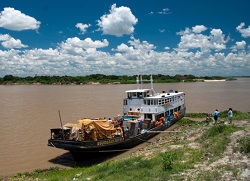A report has mapped how marijuana is trafficked through Paraguay and Argentina via thousands of kilometers of river, providing an insight into a less popular but high-capacity smuggling method.
Argentina’s La Nación has published an investigation into marijuana trafficking from Paraguay — South America’s biggest producer of cannabis — along its main river channels.
According to the newspaper, only 5 percent of the estimated 50,000 metric tons of cannabis the nation produces is consumed by Paraguayans, while up to 80 percent is reportedly smuggled into Brazil — mainly to the metropolises of São Paulo and Rio de Janeiro. The rest is trafficked to Argentina and onward to Chile.
The main transport method, La Nación reports, is via the Paraguay and Paraná Rivers, whose tributaries begin in Puerto Cáceres on the Brazilian border and head south for 3,442 kilometers, where they empty into the Atlantic Ocean near Nueva Palmira, Uruguay. (See InSight Crime’s map below. To see La Nación’s more detailed graphic, click here).

“Just over a decade ago, drug trafficking was taken over by transnational organizations,” Paraguayan Senator Eduardo Petta told La Nación, highlighting Brazil’s First Capital Command (Primeiro Comando da Capital – PCC) and the Red Command (Comando Vermelho – CV) as two of the main crime groups involved in Paraguay’s marijuana trade.
According to anti-narcotics prosecutor Ysaac Ferreira, the regional criminal structures work together like a “cooperative,” with Brazilian groups managing the marijuana supply from north Paraguay, while Paraguayans control the transport stage and Argentine groups take the drugs to market.
SEE ALSO: Coverage of Paraguay
While river trafficking is less popular than land or air-based smuggling, maritime vessels used have a much larger capacity, the report notes. Over the last year, 32 metric tons of river-bound marijuana have been seized in two shipments — a volume that would fill 80 small planes, according to La Nación.
The high number of ships travelling along the river, which can reach up to 300 a day, also makes security controls trickier. Moreover, a government document reviewed by La Nación states that Argentine officials are not authorized to conduct checks on ships that do not have Argentina as their final destination.
The report adds that boat crews are offered $10,000 to traffic drugs downstream. Marijuana producers in Paraguay are reportedly paid $30 per kilogram, while the value of the drug can reach $2,800 per kilogram if it arrives in Chile.
InSight Crime Analysis
La Nación’s detailed investigation contributes to our understanding of one of the most important criminal operations in South America. The difficulties involved in tackling illegal river trafficking may help explain why Paraguay has a struggled to chip away at its huge marijuana production industry.
The Uruguayan connection in this transnational cannabis network should not be overlooked. The river route map produced by La Nación also shows the nation’s capital Montevideo as a destination for the drugs. In fact, according to La Nación, Paraguayan, Brazilian and Argentine drug traffickers allegedly met in the capital city to coordinate a recent shipment. Uruguayan officials have stated that Paraguay supplies over 90 percent of the marijuana consumed in Uruguay.
SEE ALSO: Special Investigation: Uruguay, Organized Crime and the Politics of Drugs
Uruguay’s historic decision to legalize all stages of the marijuana trade in 2013 could be undercut by the continued influx of illegal Paraguayan cannabis. The head of Paraguay’s anti-drugs body initially complained that Uruguay’s move would increase Uruguayan demand and therefore encourage an increase in his country’s production. Indeed, the lower price of the Paraguayan product, as well as initial shortages in Uruguay’s legal supplies, could contribute to illegal marijuana continuing to cross in from Paraguay. Nevertheless, the poorer quality of the Paraguayan product may ultimately mitigate this trend.

